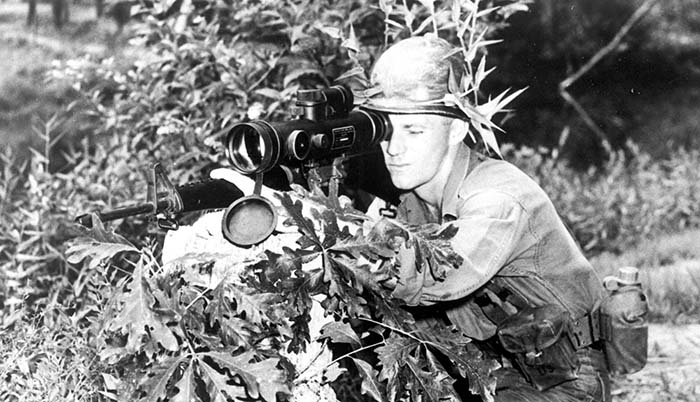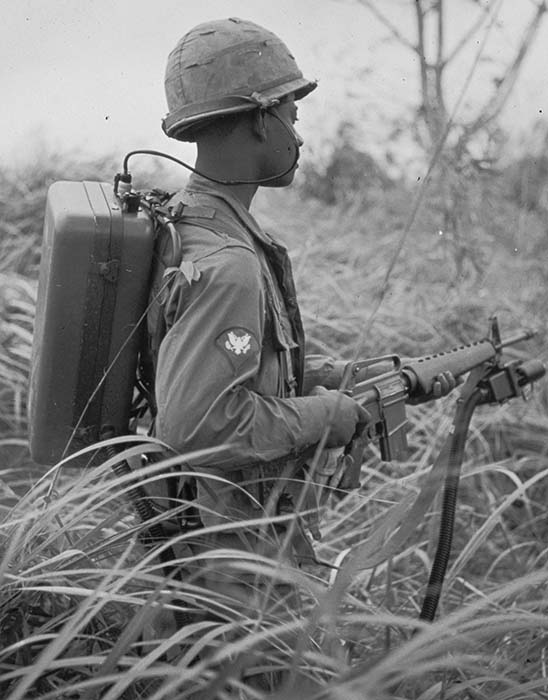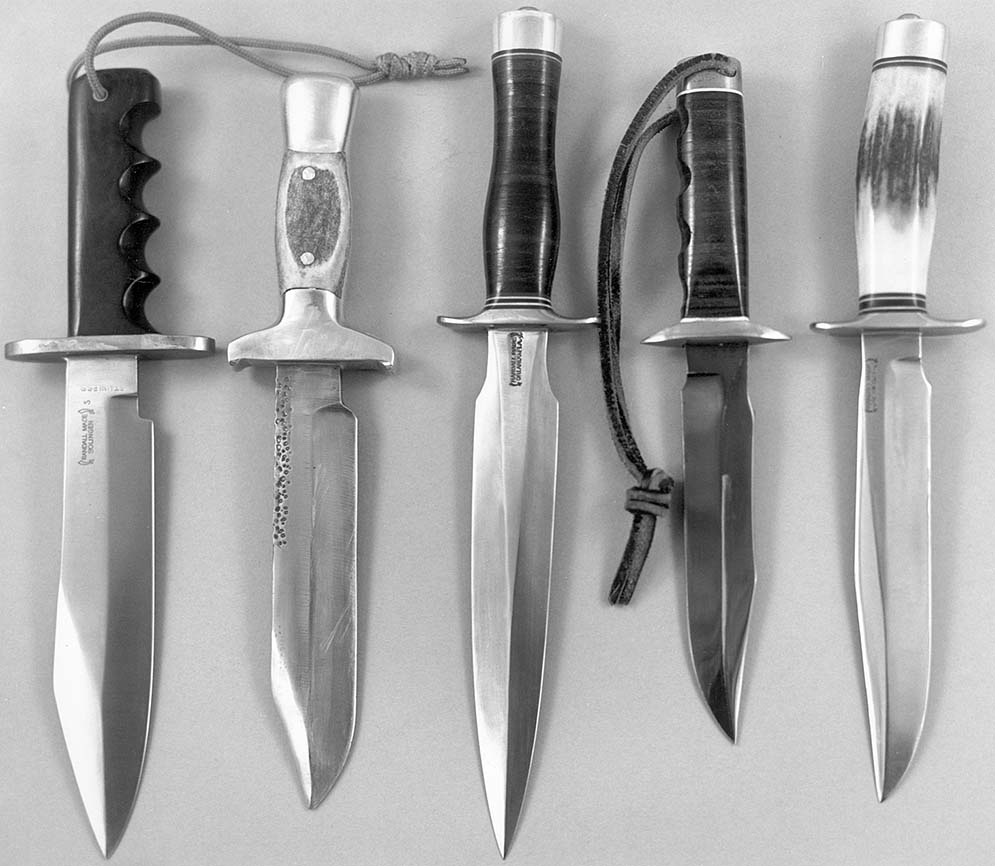By Robert Bruce
“In Washington and Saigon, and in countless laboratories, the search for gadgets was pressed hard during the Vietnam War years. To many in high levels in Washington, faith in gadgets and numbers replaced reality. By concentrating on gadgets they overlooked or ignored the need to face fundamental truths about fighting a strange war in a far-off place where the old rules did not apply and the old machines were ineffectual.” From Gadget Warfare

Many critics of America’s conduct of the Vietnam War point to what they consider a misplaced emphasis on high-technology instead of down-and-dirty counterguerrilla operations. While there were certainly some ridiculous ideas that diverted precious money and effort from the grim job at hand (the XM-2 “People Sniffer” comes immediately to mind), only a fool or a traitor would willingly deny American troops in wartime the best new weapons and related tools that minds can imagine and hands can build.

Credit: US Army/National Archives/Robert Bruce
It should make sense to most of us that, while LRRPS, Rangers and SEALs are out in the bushes sneaking, peeking and ambushing eyeball-to-eyeball, other GI’s should possess and be using Ground Surveillance Radars, or Air Delivered Seismic Detection Sensors, or anything else useful, to keep track of other enemy activities. So what if most of this stuff costs big bucks? What’s the cost-benefit cutoff point for keeping an American fighting man alive at the same time that draft dodgers like Bill Clinton were back in “the world” puffing pot (but not inhaling) and gettin’ Jody’s girl?
Tech Tools for Tough Times
Wearing heavyweight uniforms and sturdy canvas load bearing equipment designed for conditions in Europe, these first US soldiers and Marines to arrive were not ideally equipped for fighting in Vietnam’s hot and wet tropical climate and terrain. A whole lot of stuff needed to be fixed real fast.
Not only did their long and heavy M14 rifles prove only marginally effective in jungle fighting, nearly the whole family of US infantry weaponry was both over scale to the much smaller Vietnamese and a burden even to your average GI. The first significant set of technological “fixes” concerned a rifle upgrade/downsize and this saga is noted elsewhere in this special issue in my feature M14 vs. M16.
Although the rifle that had initially been derided by some soldiers and marines as the “Mattel Toy” got a rough start in Vietnam with a catalog of stoppages and breakages, this eventually got ironed out and the M16A1 began to get grudging respect from friend and foe. At the same time all this was going on, some guys in the field were asking engineers back home for various customizing jobs to tailor their “Sixteens” for specific situations.
Navy SEALs in particular asked for and got chopped versions for handier carrying in boats, helos and the bush. Most of what resulted was a trial-and-error series of cut ‘n paste “gimmicks and gadgets” going by designations like CAR-15 (short sliding buttstock and 10 in. barrel) finally to the XM177E2 (sliding tubular butt and 11.5 in. barrel tipped with improved “noise and flash suppressor”). Today’s M4 Carbine, now in use and reportedly well liked by men of all branches in Special Operations Command, is a direct descendant of this program.
In addition, all sorts of stuff got hung onto the M16 in all its forms. Some of this will be explored in greater detail later in this feature, or can be found elsewhere in this special issue. Major categories include optical and electronic sights, sound suppressors, grenade launchers, and enhanced on-board ammo capacity. One of my all-time favorite “kitchen sink” photos is one showing a USAF airfield security specialist in ‘Nam gamely shouldering the remarkable combo of M16 rifle, XM-148 grenade launcher, and AN/PVS-2 “Starlight Scope.” Let’s hope he was also issued a bipod to prop up this 17-pound jukebox when he got out on the perimeter.
Day Snipers and Night Stalkers
While the United States Marine Corps chose the tack-driving combo of Remington 700 with its powerful telescopic sight as used to legendary effect in ‘Nam by GySgt Carlos Hathcock, the Army didn’t. Without commentary, we merely report as fact that the Army tested this and other systems before choosing a highly accurized version of the M14 equipped with Lieutenant James Leatherwood’s innovative “Adjustable Ranging Telescope.”
More than a thousand specially selected, glass-bedded “Fourteens,” closely worked over by the Army’s Marksmanship Training Unit at Fort Benning then topped with a Redfield scope modified with Leatherwood’s ranging reticle and cam-elevation link, were fielded as the XM-21 Sniper Weapon System. “If you can see ‘em, you can kill ‘em,” was a popular expression among the talented breed of marksmen who employed these tools.
Things got even better for American snipers when darkness fell because our guys had the “Starlight Scope” and the bad guys didn’t. The AN/PVS system took the old 125-yard max. range of the infrared night sight of Korean War fame and updated it in a high-tech package that was essentially a television camera with light amplifier. The PVS-2, smallest of the family and usually mounted on an M16 or M14 rifle, could “see” individual enemy soldiers out to about 300 meters. Bigger versions for crew-served weapons had even greater range.
Advanced suppressor technology was another key element in avoiding unfortunate consequences of the enemy’s ability to use flash-spotting and sound-sensing to locate and react negatively toward our snipers after they had taken a shot day or night. Don’t confuse these with the old silencers that quiet the shot but must be paired with subsonic ammo to the detriment of range, accuracy and terminal effect. In contrast, suppressors developed in the Vietnam War by Sionics and the Army’s Human Engineering Lab were scientifically contrived to both minimize propellant flash and confuse the enemy as to the exact location of the shooter.

Credit: US Army Military History Institute/Robert Bruce
Ammo Advantage
Backtracking for just a moment to the SPIW program, one good thing that did emerge from that thick cloud of dust and dollars was the flechette – French (why anything French, for God’s sake?) for “little arrow.” These finned steel needles never made it big as individual rifle rounds but they sure caused a stir when bundled into conventional loads like the XM258 12 gauge shotgun shell and a short-lived experimental 40mm grenade for use by SEALs and Marine Recon in their M79’s and XM-148’s.
Squeeze ‘n Poop
Another multiple-projectile concept tried in Vietnam was a “SALVO Squeeze Bore” that could ingeniously turn an ordinary .50 cal. machine gun into a .30 caliber full auto, serial-slug shotgun. This was a “Brown Water Navy” initiative driven by Riverine operations where max firepower at relatively short ranges was needed and there were plenty of M2HB machine guns on hand. Great idea – stack five short, conical .50 cal bronze slugs in a standard length cartridge case and fire them in a regular gun equipped with a special barrel that tapers from .50 cal. at the throat to .30 cal. at the muzzle.
Detonation of each round sent a stack of five projectiles rushing down an ever-narrowing barrel where, as Navy engineer Carroll Childers colorfully explains, “They were re-formed into .30 caliber and they separated from each other because they were cones being squeezed, so they sort of pooped each other out the back.”
Sadly, its first in-country, actual firefight test was marred by an overly-excited .50 cal gunner who, responding to VC fire from the riverbank, hit the triggers and didn’t let up until the weapon’s expensive and irreplaceable one-of-a-kind barrel nearly melted. Sorry ‘bout that. Shoulder-Fired Artillery
The replacement for the awkward and troublesomely electrical-fired bazooka was the real star of America’s manportable artillery arsenal in Vietnam. This was the M72 LAW – Light Antitank Weapon – an ingenious telescoping tube with a 66mm High Explosive Antitank Rocket hermetically sealed inside, and mechanically fired without batteries or magnetos using a percussion primer. The whole tube/rocket combo weighed just 4.68 pounds vs. 9 pounds just for the old bazooka’s rocket alone, with small sacrifice in range and punch. The thing was also disposable so, after firing, the gunner smashes the now-empty tube to keep “Charlie” from using it and then drives on.
Since the enemy didn’t have many armored vehicles until late in the war, most of the handy LAW’s were employed against VC or NVA in bunkers or for breaching walls in the kind of savage house-to-house fighting that characterized TET ’68. Good stuff, but wait, it gets better.
Burn Baby, Burn!
The flamethrower has long been a dandy tool for a number of combat situations such as roasting stubborn occupants of bunkers, pillboxes and caves. Unfortunately, because the things are heavy, complicated and require lots of logistical support, they aren’t always handy when suitable scenarios develop. Hummm, how about a high-tech answer?
The M202 rocket launcher is a fiery four-barreled pepperbox that takes the tube munition concept to spectacular levels. Looking for all the world like a rectangular bundle of four LAW’s equipped with an optical sight, the 202 also fires 66mm rockets but with some radical departures. Instead of launching a shaped-charge HEAT warhead, each rocket is loaded with 1.3 pounds of “thickened pyrophoric agent,” a substance similar to white phosphorous which burns spontaneously when exposed to air.
So, with relatively little fuss and muss, the 26.6 pound M202 could be pulled off the truck or APC, brought up on line and immediately fired out to ranges more than 10 times that of a standard issue M2A1-7 Portable Flamethrower. Need more than four rounds real quick? Slam in another four-pack clip of M74 pyrophoric rockets and light ‘em up.
Road Warriors
Though perhaps not as much in the “gimmicks & gadgets” category as in the “GI Ingenuity” department, armored gun trucks are worthy of inclusion in this report. These little-known but extremely colorful homemade rolling battlewagons were scratch built by Transportation Corps truck-troopers to protect their daily supply convoys from energetic and persistent ambushes.
Finding little suitable or available in the Army’s combat vehicle inventory, they took jeeps, deuces and 5-tons and welded on steel plate armor and then festooned the resultant landships with all manner of scrounged and salvaged weaponry. Everything from hand-held M60’s through multi-mount .50 cal’s and electrically-operated Miniguns were “found” and used in a deadly game of cavalry and Indians that was particularly ugly along QL 19 from Qui Nhon to Pleiku in the Central Highlands.
he only surviving example we know of, of this unauthorized but ubiquitous form of armored fighting vehicle from Vietnam is “Eve of Destruction,” a 5 ton truck mounting five .50 cal. M2HB’s, now resting comfortably inside the US Army Transportation Museum at Ft. Eustis, VA. Gx3 From A-Z
Sadly, space limitations preclude any but the briefest mention of many other fascinating gimmicks, gadgets and guns used in Vietnam. Those whose appetite for the subject has been whetted here are strongly encouraged to delve into the books listed below. There, one will encounter Project AGILE, “Puff the Magic Dragon,” Patrol Air Cushion Vehicles, Rome Plows, Daisy Cutters, Fuel-Air Explosives, McNamara’s Fence, Igloo White, miniature squad radios, psyops, MicroGravel Mines, Controlled Fragmentation Munitions, body armor and barefoot boots, Tiara paste, Pave Eagle, Electro-Optical Guided Bombs, Nighthawk Hueys, ACAV APC’s, and all manner of other alphabet soup enigmas.
Primary References
GADGET WARFARE (Illus. Hist. of Vietnam War Series), Bantam Books, 1988
PERSONAL FIREPOWER (Illus. Hist. of Vietnam War Series), Bantam Books, 1988
TOOLS OF WAR (Vietnam Experience Series), Boston Publishing, 1985
| This article first appeared in Small Arms Review V5N7 (April 2002) |












